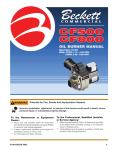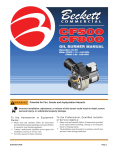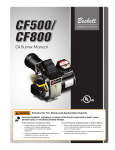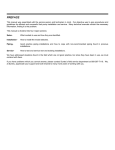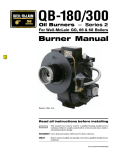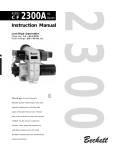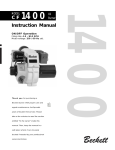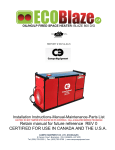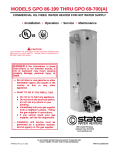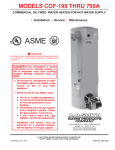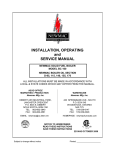Download Beckett CF 500/800 User's Manual
Transcript
CF Oil Burner Instruction Manual ON/OFF Operation Firing rate: CF500: 1.75 – 5.50 GPH CF800: 3.00 – 8.00 GPH Motor voltage: 120 / 60 Hz std. Thank you for purchasing a Beckett burner. With proper care and regular maintenance, it will provide years of trouble-free service. Please take a few minutes to read the section entitled “To the owner” inside this manual. Then, keep the manual in a safe place where it can be easily located if needed by your professional service technician. 500/800 500/ CF 800 MODEL Instruction Manual – Model CF500/CF800 Oil Burner Please . . . read this page first Hazard definitions The following will be used throughout this manual to bring attention to hazards and their risk factors, or to special information. Denotes presence of a hazard which, if ignored, will result in severe personal injury, death or substantial property damage. Denotes presence of a hazard which, if ignored, could result in severe personal injury, death or substantial property damage. Denotes presence of a hazard which, if ignored, could result in minor personal injury or property damage. Intended to bring special attention to information, but not related to personal injury or property damage. To the owner — Installation and adjustment of the burner requires technical knowledge and the use of combustion test instruments. Do not tamper with the unit or controls. Call your qualified service technician. Incorrect operation of the burner could result in severe personal injury, death or substantial property damage. Have your equipment inspected and adjusted at least annually by your qualified service technician to assure continued proper operation. Never attempt to use gasoline in your heating appliance or to store gasoline or combustible materials near the heating equipment. This could result in an explosion or fire, causing severe personal injury, death or substantial property damage. To the installer — Read all instructions before proceeding. Follow all instructions completely. Failure to follow these instructions could result in equipment malfunction, causing severe personal injury, death or substantial property damage. This equipment must be installed, adjusted and started only by a qualified service technician—an individual or agency, licensed and experienced with all codes and ordinances, who is responsible for the installation and adjustment of the equipment. The installation must comply with all local codes and ordinances and with the National Fire Protection Standard for Oil-Burning Equipment, NFPA 31 (or CSA B139-M91). 2 To the owner — Never burn garbage or refuse in your heating appliance or try to light the burner by tossing burning material into the appliance. This could result in severe personal injury, death or substantial property damage. Never attempt to use crankcase or waste oil in your heating appliance. This could damage the fuel unit or heating equipment, resulting in risk of severe personal injury, death or substantial property damage. Never restrict air openings on the burner or to the room in which the appliance is located. This could result in fire hazard or flue gas leakage, causing severe personal injury, death or substantial property damage. To the installer — Concealed damage - If you discover damage to the burner or controls during unpacking, notify the carrier at once and file the appropriate claim. Contacting Beckett for service information or parts - Please record the burner serial number (and have available when calling or writing). You will find the serial number on the Underwriters Laboratories label, located on the left rear of the burner. High altitude installations — Accepted industry practice requires no derate of burner capacity up to 2,000 feet above sea level. For altitudes higher than 2,000 feet, derate burner capacity 4% for each 1000 feet above sea level. Form 6104 BCF5-R0301 Instruction Manual – Model CF500/CF800 Oil Burner Warranty Contents Beckett warrants its equipment to those who have purchased it for resale, including your dealer. If you have any problems with your equipment or its installation, you should contact your dealer for assistance. Please . . . read this page first ................ 2 Pre-installation checklist........................... 4 Refer to warranty sheet in literature packet included with burner for details. Mount the burner .......................................... 6 Specifications Fuels #1 or #2 Fuel Oil Firing range CF500: 1.75 – 5.50 GPH Connect fuel line(s) ...................................... 8 Wire the burner — R7184 ......................... 10 CF800: 3.00 – 8.00 GPH Motor 1 /3 HP 3450 RPM Wire the burner — R8184 (alternate) .. 11 120/60 hz standard 4.8 amps @ 120 VAC Ignition Trans. 120V/10,000V Housing Cast aluminum Fuel unit 100 - 200 PSIG Oil nozzle 45° - 70° solid Shipping wt. 55 lbs. Prepare the burner for start-up ............. 12 Start the burner .......................................... 13 Maintenance and service......................... 14 Replacement parts ..................................... 15 Agency approvals • Underwriters Laboratories has certified this burner to comply with ANSI Standard 296 and has listed it for use with No. 1 or No. 2 fuel oil as specified in ASTM D396. State and local approvals appear on the burner rating label. • Certified by ULC. • Approved by Commonwealth of Massachusetts - State Fire Marshall. • Accepted by N.Y.C. M.E.A. • Other approvals may be available and must be specified at time of order. Before you begin . . . The following resources will give you additional information for your installation. We suggest that you consult these resources whenever possible. Pay particular attention to the appliance manufacturer’s instructions. Appliance manufacturer’s instructions — Always follow the appliance manufacturer’s instructions for burner installation, equipment and set-up. 1–800–OIL–BURN — Beckett’s technical services hot-line. www.beckettcorp.com — Beckett’s website. Form 6104 BCF5-R0301 3 Instruction Manual – Model CF500/CF800 Oil Burner Pre-installation checklist ❏ Combustion air supply ❏ Vent system • The burner requires combustion air and ventilation air for reliable operation. Assure that the building and/or combustion air openings comply with National Fire Protection Standard for Oil-Burning Equipment, NFPA 31. For appliance/burner units in confined spaces, the room must have an air opening near the top of the room plus one near the floor, each with a free area at least one square inch per 1,000 Btu/hr input of all fuel burning equipment in the room. For other conditions, refer to NFPA 31 (CSA B139M91 in Canada). • If there is a risk of the space being under negative pressure or of exhaust fans or other devices depleting available air for combustion and ventilation, the appliance/burner should be installed in an isolated room provided with outside combustion air. • The flue gas venting system must be in good condition and must comply with all applicable codes. ❏ Clearances • Pedestal mounting assembly kit (recommended) • With the burner installed in the appliance, there must be adequate space in front of and on the sides of the burner to allow access and operation. Verify that the clearance dimensions comply with all local codes and with the appliance manufacturer's recommendations. • Oil nozzle, per Table 1 — Use only 45° to 70° solid pattern nozzles unless otherwise shown by appliance manufacturer. Find the required firing rate in the 150 psig column (factory-set fuel unit pressure). Select the corresponding nozzle from column 1 (Rated gph @ 100 psig). ❏ Fuel supply • The fuel supply piping and tank must provide #1 or #2 fuel oil at pressure or vacuum conditions suitable for the fuel unit (oil pump) on the burner. Refer to fuel unit literature in the literature envelope in the burner carton to verify allowable suction pressure. The fuel unit is shipped without the by-pass plug installed for CF500/CF800 ON/OFF burners. You must install this plug on twopipe systems. DO NOT install the by-pass plug in the fuel unit if connected to a one-pipe oil system. Failure to comply could cause fuel unit seal failure, oil leakage and potential fire and injury hazard. ❏ Electrical supply • Verify that the power connections available are correct for the burner. All power must be supplied through fused disconnect switches. ❏ Verify burner components — • Burner box, Model CF500 and CF800 • Air tube assembly (selected per following) • Mounting flange kit Table 1 - Nozzle capacities Rated gph @ 100 psig Pressure - pounds per square inch 140 150 1.75 2.07 2.14 2.00 2.37 2.45 2.25 2.66 2.74 2.50 2.96 3.06 If fuel supply is level with or higher than fuel unit — 2.75 3.24 3.37 • When the fuel unit is not required to lift the oil, the installation is usually suitable for either a one-pipe or two-pipe oil system. The oil pressure at the inlet of the fuel unit must not exceed 3 psig. • See Figure 7 for one-pipe fuel supply installations. See Figure 8 for two-pipe fuel supply installations. 3.00 3.55 3.68 3.50 4.13 4.29 4.00 4.70 4.90 4.50 5.30 5.51 If fuel supply is below the fuel unit — 5.00 5.90 6.13 • Use a two-pipe oil system when the fuel unit must lift the oil more than 8 feet if burner is equipped with a B fuel unit. The return line provided by the two-pipe system is needed to purge the air from the fuel lines and minimize the likelihood of air-related problems during operation. 5.50 6.50 6.74 6.00 7.10 7.33 6.50 7.65 7.96 4 Form 6104 BCF5-R0301 Instruction Manual – Model CF500/CF800 Oil Burner ❏ Verify firing rate Figure 2 - Air tube mounting dimensions • Refer to appliance manufacturer’s instructions (if available) for firing rate and nozzle selection. Otherwise, the maximum recommended firing rate for the burner depends on the length of the firing chamber and the distance from the burner center to the chamber floor. Verify that the chamber dimensions are at least as large as the minimum values given in Figure 1. If the appliance dimensions are smaller than recommended, reduce the firing rate accordingly. ❏ Verify air tube • The information in this section may be disregarded if the air tube is supplied by the appliance manufacturer. • Tube arrangements available: CF500: 1.75 to 5.50 GPH CF800: A Tube — 3.00 to 7.00 GPH B Tube — 5.00 to 8.00 GPH • Maximum firing capacity depends on the firebox pressure. Use Table 2 to verify the correct air tube for the firing rate required. • See Figure 2 to verify the correct air tube length and air tube combination code. Figure 1 - Min. Combustion chamber dimensions Air tube length (Dimension T) 6.00" 8.00" 10.00" 14.00" 16.00" 17.00" A.T.C. Codes (A.T.C. = Air Tube Combination) CF500 CF 60 KK CF 80 KK CF 100 KK CF 140 KK CF 160 KK -- CF800 Tube A CF 60 KH CF 80 KH CF 100 KH CF 140 KH -CF 170 KH Tube B CF 60 KJ CF 80 KJ CF 100 KJ CF 140 KJ -CF 170 KJ Table 2 - Air tube capacity vs. firebox pressure Firebox pressure (In. w.c.) CF500 Tube KK (GPH) CF800 Tube KH (GPH) Tube KJ (GPH) No reserve air Firing rate GPH 1.75 to 3.00 4.00 5.00 6.00 7.00 8.00 Minimum dimensions (inches) With damper Without damper A L A L 7.5 18.0 8.0 19.0 8.0 21.0 9.5 23.0 9.0 23.0 10.5 30.0 10.0 28.0 11.5 40.0 11.0 34.0 12.0 46.0 14.0 38.0 14.0 51.0 Form 6104 BCF5-R0301 0.0 5.50 7.00 8.00 0.1 4.75 6.25 7.50 0.2 4.00 5.50 6.75 0.3 3.50 4.50 6.25 0.4 2.75 3.75 5.50 0.5 2.00 3.00 5.00 Note: The above ratings may vary 5% due to variations in actual job conditions. 5 Instruction Manual – Model CF500/CF800 Oil Burner Mount the burner ❏ Mount flange(s) on air tube Figure 3 - Mount flange(s) on air tube • This section does not apply to burners with welded flanges. • Do not install air tube on burner. • For non-pressure firing flange, refer to Figure 3: Install gasket (item a ) and flange (item d ). Ignore the next paragraph. • For pressure-firing flange, refer to Figure 3: Slide gasket (item a) onto the air tube, making sure the top of the air tube is up. Pre-drill holes in the pressure firing plate (item b) to match the appliance studs. Slide the pressure firing plate (item b) and flange (item d) onto the air tube as shown. Wrap ceramic fiber rope (item c) around the air tube and press tightly into the inside diameter of the flange (item d). • Slide the air tube (item e) into position in the appliance front. Tighten the flange-mounting-stud nuts. Set the insertion of the air tube so dimension G is ¼" nominal. • Pitch the air tube at 2° from horizontal as shown and secure the flange to the air tube. Figure 4 - Nozzle and nozzle line assembly ❏ Mount air tube to burner • Attach the air tube to the burner with the screws provided. ❏ Install nozzle • See Figure 4. Install the oil nozzle in the nozzle adapter. Use a ³⁄₄" open-end wrench to steady the nozzle adapter and a ⁵⁄₈" open-end wrench to turn the nozzle. Tighten securely but do not over-tighten. • Check, and adjust if necessary, the critical dimensions shown in the drawing. Verify that the oil tube assembly and electrodes are in good condition, with no cracks or damage. 6 Failure to properly set and maintain the electrode and nozzle spacing dimensions can cause incorrect burner ignition or poor combustion. This could result in severe personal injury, death or substantial property damage. Form 6104 BCF5-R0301 Instruction Manual – Model CF500/CF800 Oil Burner ❏ Install nozzle line assembly Figure 5 - Nozzle line assembly in burner • Insert the nozzle line assembly into the burner air tube. • Slide the secondary adjusting plate (Figure 6, item f) completely to the left on the indicator adjusting plate (item e). Finger-tighten acorn nut c to secure the two plates together. Slide both plates completely to the right (Indicator plate will read 0). Tighten fastener d. • Install the spline nut on the end of the nozzle line, leaving the nut loosely placed so the plates can be moved. ❏ Set dimension Z • Loosen fastener c in Figure 6. Slide the nozzle line and plate assembly until dimension Z in Figure 5 is: CF500 — 19/16" ± 1/16" Figure 6 - Adjusting plate assembly CF800 — 13/4" ± 1/16" When dimension Z (from end of air tube to flat area of front face of head) is correctly set, tighten acorn nut c. • Attach the oil line from the oil valve to the nozzle line end. Tighten securely. • Before proceeding, check dimension Z once again. Loosen acorn nut c if necessary to reposition the nozzle line. Once dimension Z is set, do not loosen acorn nut again. For the setting of fastener d, refer to page 12. ❏ Insert burner Legend c d e f acorn nut fastener Indicator adjusting plate Secondary adjusting plate • Position the burner in the front of the appliance and loosely tighten the nuts on the mounting studs. The burner should be pitched downward 2° as shown in Figure 3. Form 6104 BCF5-R0301 7 Instruction Manual – Model CF500/CF800 Oil Burner Connect fuel line(s) Install the oil lines using the following guidelines. Failure to comply could lead to equipment damage and present a risk of severe personal injury, death or substantial property damage due to leakage of oil and potential fire hazard. Use only flare fittings at joints and connections. Never use compression fittings. Install fittings only in accessible locations to assure any leak will be detected. Where joint sealing is needed, use only pipe dope. Never use Teflon tape. Tape strands can break free and damage the fuel unit. Never use a one-pipe oil system with a lift in excess of 8 feet with B fuel unit. On two-pipe oil systems, verify that the suction line vacuum does not exceed the fuel unit manufacturer’s recommendation. The fuel unit is shipped without the by-pass plug installed for CF500/CF800 ON/OFF burners. You must install this plug on twopipe systems. DO NOT install the by-pass plug in the fuel unit if connected to a one-pipe oil system. Failure to comply could cause fuel unit seal failure, oil leakage and potential fire and injury hazard. ❏ Fuel unit by-pass plug • The CF500/CF800 burner is shipped without the by-pass plug installed in the fuel unit. • The by-pass plug must not be installed in the fuel unit for one-pipe oil systems. • You must install the by-pass plug if using on a two-pipe oil system. ❏ Oil supply/return lines • Install the oil tank and oil lines in accordance with all applicable codes. • Size the oil supply and return lines using the guidelines given in the fuel unit literature included in the literature envelope. Oil line flow rate will equal the burner rate for one-pipe systems. For two-pipe systems, refer to Table 3 for the fuel unit gearset capacity - the rate at which fuel is recirculated when connected to a two-pipe system. Size two-pipe oil lines based on this flow rate. • Use continuous lengths of heavy-wall copper tubing, routed under the floor where possible. Do not attach fuel lines to the appliance or to floor joists if possible. This will reduce vibration and noise transmission problems. • Install an oil filter sized to handle the fuel unit gearset flow capacity (Table 3) for two-pipe systems. Size the filter for the firing rate for one-pipe systems. Locate the filter immediately adjacent to the burner fuel unit. • Install two high-quality shut-off valves in accessible locations on the oil supply line. Locate one valve close to the tank. Locate the other valve close to the burner, upstream of the fuel filter. 8 Form 6104 BCF5-R0301 Instruction Manual – Model CF500/CF800 Oil Burner ❏ Burner fuel flow Figure 7 – One-pipe oil flow with “B” pump • One-pipe systems – See Figure 7 for the fuel flow path. • Oil supply connects to one of the fuel unit inlet ports. • Two-pipe systems – See Figure 8 for the fuel flow paths for two-pipe oil systems. • Oil supply connects to one of the fuel unit inlet ports. Oil return connects to the fuel unit return port. (Install the by-pass plug in the fuel unit for two-pipe systems.) Figure 8 – Two-pipe oil flow with “B” pump • Nozzle pressure – The fuel unit nozzle port pressure is factory set at 140 psig. Some original equipment manufacturer burner applications may call for a lower pressure to obtain a required firing rate. Do not change this pressure unless directed to do so by the appliance manufacturer. Legend Table 3 – Fuel unit gearset capacities Fuel unit model number Gearset capacity (GPH) A2VA-7116 17 A2YA-7916 20 B2VA-8216 21 B2YA-8916 25 B2TA-8248 21 Form 6104 BCF5-R0301 a b c d Return port Nozzle port Oil valve Nozzle & adapter g Inlet port k Return line to oil tank p Air bleed valve 9 Instruction Manual – Model CF500/CF800 Oil Burner Wire the burner — R7184 Install the burner and all wiring in accordance with the National Electrical Code and all applicable local codes or requirements. Wire the burner in compliance with all instructions provided by the appliance manufacturer. Verify operation of all controls in accordance with the appliance manufacturer's guidelines. See Figure 9a for a typical wiring diagram, with R7184 oil primary, for reference purposes only. Sequence of operation — typical Do not by-pass any safety control. By-passing a safety control could result in severe personal injury, death or substantial property damage. Electrical shock hazard - can cause injury or death. Disconnect power before installing or servicing. Provide ground wiring to the burner in accordance with the National Electrical Code. Figure 9a – Typical wiring 1. Standby — The burner is idle, waiting for a call for heat. When a call for heat is initiated, there is a 2- to 6-second delay while the control performs a safe start check. 2. Valve-on delay — As applicable, the ignition and motor are turned on for a 15-second prepurge. 3. Trial for ignition (TFI) — The fuel valve is opened, as applicable. A flame should be established within the 15second lockout time (30-second lockout time is available). 4. Lockout — If flame is not sensed by the end of the TFI, the control shuts down on safety lockout and must be manually reset. If the control locks out three times in a row, the control enters restricted lockout. Call a qualified service technician. 5. Ignition carryover — Once flame is established, the ignition remains on for 10 seconds to ensure flame stability. It then turns off. 6. Run — The burner runs until the call for heat is satisfied. The burner is then sent to burner motor-off delay, as applicable, or it is shut down and sent to standby. 7. Recycle — If the flame is lost while the burner is firing, the control shuts down the burner, enters a 60-second recycle delay, and then repeats the ignition steps outlined above. If the flame is lost three times in a row, the control locks out to prevent continuous cycling with repetitious flame loss caused by poor combustion. 8. Burner motor-off delay — If applicable, the fuel valve is closed and the burner motor is kept on for the selected postpurge time before the control returns the burner to standby. 1 Standby 2 Valve-on delay 3 5 Trial for ignition 10 Lockout Ignition carryover 8 Motor-off delay (postpurge) 4 Legend 7 6 Run Recycle FD LM OP PR CC Fused disconnect, by others Limit controls, by others Operating controls, by others Oil primary control, R7184 typical Flame sensor, cad cell typical TR M1 S1 T-T F-F Ignition transformer Burner motor Oil valve 24-volt thermostat/limit terminals Cad cell flame sensor terminals Form 6104 BCF5-R0301 Instruction Manual – Model CF500/CF800 Oil Burner Wire the burner — R8184 (alternate) Install the burner and all wiring in accordance with the National Electrical Code and all applicable local codes or requirements. Do not by-pass any safety control. By-passing a safety control could result in severe personal injury, death or substantial property damage. Wire the burner in compliance with all instructions provided by the appliance manufacturer. Verify operation of all controls in accordance with the appliance manufacturer's guidelines. Electrical shock hazard - can cause injury or death. Disconnect power before installing or servicing. Provide ground wiring to the burner in accordance with the National Electrical Code. See Figure 9b for an alternate wiring diagram, with R8184 oil primary, for reference purposes only. Figure 9b – Alternate wiring R8184 Sequence of operation — typical 1. Standby — The burner is idle, waiting for a call for heat. 2. Trial for ignition (TFI) — The fuel valve is opened, as applicable. A flame should be established within the 15second lockout time (30-second lockout time is available). 3. Lockout — If flame is not sensed by the end of the TFI, the control shuts down on safety lockout and must be manually reset. • To reset the control after lockout, wait 2 to 3 minutes after lockout to give the internal switch time to cool. • Then push the reset button on the primary control, allowing the burner to operate in normal sequence. • Troubleshoot the reason for the flame sense failure. 4. Run — The burner runs until the call for heat is satisfied. 1 Standby 2 Trial for ignition 3 Lockout 4 Run Legend FD LM OP PR CC Form 6104 BCF5-R0301 Fused disconnect, by others Limit controls, by others Operating controls, by others Oil primary control, R8184 typical Flame sensor, cad cell typical TR M1 S1 T-T F-F Ignition transformer Burner motor Oil valve 24-volt thermostat/limit terminals Cad cell flame sensor terminals 11 Instruction Manual – Model CF500/CF800 Oil Burner Prepare the burner for start-up Start-up checklist – Verify the following before attempting to start burner. ❏ Combustion air supply and venting have been inspected and verified to be free of obstructions and installed in accordance with all applicable codes. ❏ Oil nozzle has been selected correctly and securely installed in the nozzle adapter. ❏ Fuel unit by-pass plug has not been installed for one-pipe oil system. By-pass plug has been installed for two-pipe oil system. ❏ Fuel connection to nozzle line assembly is secure. ❏ Dimension Z has been set per this instruction manual. ❏ Fuel supply line is correctly installed, the oil tank is sufficiently filled, and shut-off valves are open. ❏ Burner is securely mounted in appliance, with pressure firing plate and gasket installed for pressurized chamber application. ❏ Appliance has been filled with water (boilers) and controls have been operationally checked. ❏ Burner has been installed in accordance with appliance manufacturer’s instructions (when available). ❏ Also refer to appliance manufacturer’s instructions (when available) for start-up procedures. ❏ Z dimension • Should be set per these instructions (see page 7). The acorn nut (Figure 6, item c, page 7) should never be loosened once the Z dimension is initially set. ❏ Initial head position • The indicator plate assembly markings correspond to head position settings. • Loosen the fastener (Figure 6, item d, page 7) and slide the indicator plate until the number on the plate corresponds to the initial head setting given in Table 4 for the desired firing rate. • When the head position has been set, tighten the fastener and spline nut. ❏ Initial air settings • Loosen the air band and shutter, and adjust to the settings for the applicable firing rate shown in Table 5. • These initial settings should be adequate for starting the burner. Once the burner is in operation, the air settings will 12 be adjusted for best performance as discussed later in this manual. • Follow the procedures given later in this manual for finetuning the air settings. ❏ Set appliance limit controls • Set the appliance limit controls in accordance with the appliance manufacturer's recommendations. ❏ Prepare the fuel unit for air venting • To vent air from one-pipe oil systems, attach a clear hose to the vent plug on the fuel unit. Provide a container to catch the oil. Loosen the vent plug. • Vent the air as described under Start the burner, page 13, when using the R7184 control. Table 4 – Initial indicator adjustment plate settings (head position) Rate GPH Approximate head settings CF500 CF800 Tube A Tube B 0 --0 4 0 -5 1 -5 2 -6 4 3 6 4 4 -4 4 -6 5 --6 1.75 2.25 3.00 3.50 4.00 5.00 5.50 6.00 7.00 8.00 Table 5 – Initial air settings Rate GPH 1.75 2.25 3.00 3.50 4.00 5.00 5.50 6.00 7.00 8.00 Approximate air settings CF500 CF800 Tube A Tube B Shutter Band Shutter Band Shutter Band 1 2 10 10 10 10 10 ---- 0 0 1 2 3 5 10 ---- --1 3 4 9 9 10 10 -- --0 0 0 0 5 3 8 -- -----8 9 10 10 10 -----2 4 3 5 10 Form 6104 BCF5-R0301 Instruction Manual – Model CF500/CF800 Oil Burner Start the burner Do not proceed unless all prior steps in this manual have been completed. Failure to comply could result in severe personal injury, death or substantial property damage. Do not attempt to start the burner when excess oil has accumulated, when the appliance is full of vapor or when the combustion chamber is very hot. Do not attempt to re-establish flame with the burner running if the flame should be extinguished during start-up, venting or adjustment. Allow the unit to cool off and all vapors to dissipate before attempting another start. Failure to comply with these guidelines could cause an explosion or fire, resulting in severe personal injury, death or substantial property damage. If control is not an R7184 refer to manufacturer’s literature for specific control. Resetting from restricted lockout • If the control locks out three times in a row without a complete heat cycle between attempts, the lockout becomes restricted. A qualified service technician should be called to inspect the burner. Disable function • Any time the motor is running, press and hold the reset button to disable the burner. The burner will remain off as long as the button is held and will return to standby when released. Cad cell resistance check • While the burner is firing, and after the ignition has been turned off, press and release the reset button (hold ½second or less) to check the cad cell resistance. The LED will flash 1 to 4 times, depending on the cad cell resistance (see the table below). For proper operation, it is important that the cad cell resistance is below 1600 Ohms. ❏ Starting the burner and venting air LED flashes Cad cell resistance Priming the pump 1 0-400 Ohms 1. Initiate a call for heat. 2 400-800 Ohms 2. While the ignition is on, press and release the reset button (hold ½-second or less). If the control has not locked out since its most recent complete heat cycle, the lockout time will be extended to 4 minutes (45 seconds in earlier units), and the ignition will remain on the entire heat cycle. 3 800-1600 Ohms 4 more than 1600 Ohms 3. Bleed the pump until all froth and bubbles are purged. If prime is not established within the extended lockout time, the control will lock out. Press the reset button to reset the control and return to step 2. The reset button can be held for 30 seconds at any time to reset the control’s lockout counter to zero and send the control to standby. 4. Repeat steps 2 and 3, if needed, until the pump is fully primed and the oil is free of bubbles. Then terminate the call for heat, and the control will resume normal operation. Form 6104 BCF5-R0301 LED Indicator key LED Status On Flame sensed Off Flame not sensed Flashing (½-second on, ½-second off) Lockout/ Restricted lockout Flashing (2 seconds on, 2 seconds off) Recycle 13 Instruction Manual – Model CF500/CF800 Oil Burner Start the burner continued ❏ Set air adjusting plate 1. Allow the burner to run until the appliance has warmed sufficiently. b. Increase the air to reduce CO2 by 2 percentage points at a zero smoke level. (Increase O2 by 3 percentage points at a zero smoke level.) Example: Reduce CO2 from 13.5% to 11.5%, with zero smoke (or increase O2 from 2.5% to 5.5%). 2. Visually check the flame. The flame should not be dark orange or smoky. If the flame appears to be smoking, increase the amount of air by re-adjusting the air band to a higher number. 3. Once the appliance has warmed, the air setting can be checked and adjusted. 4. Use combustion test instruments to adjust the burner. a. Adjust the air until a trace of smoke is achieved with CO2 level as high as possible (lowest possible O2). Example: 13.5% CO2 (2.5% O2) with a trace of smoke. c. This procedure provides a margin of reserve air to accommodate variable conditions. 5. Check the breech draft pressure against the appliance manufacturer’s recommended setting (typically + 0.1" W.C.). 6. If the breech pressure is higher or lower than recommended level, adjust the appliance breech damper to achieve the specified setting. Recheck the smoke and CO2 levels. Adjust burner air if necessary. Maintenance and service The burner must be serviced at least annually by a qualified service technician to assure continued reliable operation. Operation and adjustment of the burner requires technical knowledge and the use of combustion test instruments. Do not tamper with the burner or controls. Failure to comply could result in failure of the burner or system, resulting in severe personal injury, death or substantial property damage. Annual service ❏ Inspect combustion air and vent systems. — by qualified service technician ❏ Replace oil filter. Have the burner inspected, tested and started at least annually by a qualified service technician. This annual test/inspection should include at least the following: ❏ Oil motor (if not permanently lubricated). ❏ Replace oil nozzle. ❏ Clean burner and blower wheel (if needed to remove lint or debris). ❏ Test ignition and combustion and verify air settings. ❏ Test oil supply line vacuum - verify that it is within allowable range indicated in fuel unit literature. ❏ Check pump pressure to nozzle. ❏ Inspect fuel system (including tank, lines and all connections). 14 Monthly maintenance — by owner ❏ Observe combustion air openings and vent system for integrity. Openings must be clean and free of obstructions. ❏ Check oil lines and fittings to verify there are no leaks. ❏ Observe burner ignition and performance to verify smooth operation. ❏ Shut the system down if you observe abnormal or questionable operation. Call a qualified service agency for professional inspection and service. Form 6104 BCF5-R0301 Instruction Manual – Model CF500/CF800 Oil Burner Replacement parts Item 1 2 3 4 5 6 Part name Air tube Flange kit Electrode assembly Air shutter Nozzle line assembly Head assembly 7 8 10 11 12 17 20 21 Fuel lines Air band Adjusting plate assembly Spline nut Fuel pump Coupling Control Ignitor -22 23 Transformer Motor Blower wheel 24 Pedestal kits Description Refer to Figure 2, page 5 Refer to Figure 10, below Part number Specify 3215 Refer to Figure 2, page 5 CF500 — KK CF800 — KH (Tube A) CF800 — KJ (Tube B) Specify lengths 51401U 51252P 51302P 3819 51286 3666 Refer to Table 3, page 9 2433 Specify 14,000 volt France 14,000 volt Allanson 13 / HP CF500 — 5 19/32" x 2 13/32" CF800 — 6 5/16" x 2 3/8" Extended Standard 7440 7438 2289 21341U 21448U 21339U 5606 5685 Figure 10 – Adjustable mounting plates for CF500/CF800 Form 6104 BCF5-R0301 15 Instruction Manual – Model CF500/CF800 Oil Burner U.S.A.: P. O. Box 1289 • Elyria, Ohio 44036 • 800-645-2876 • 440-327-1060 • FAX 440-327-1064 Canada: R. W. Beckett Canada, Ltd. • 430 Laird Road • Guelph, Ontario, N1G 3X7 • 800-665-6972 • FAX 519-763-5656 Form 6104 BCF5-R0301
















